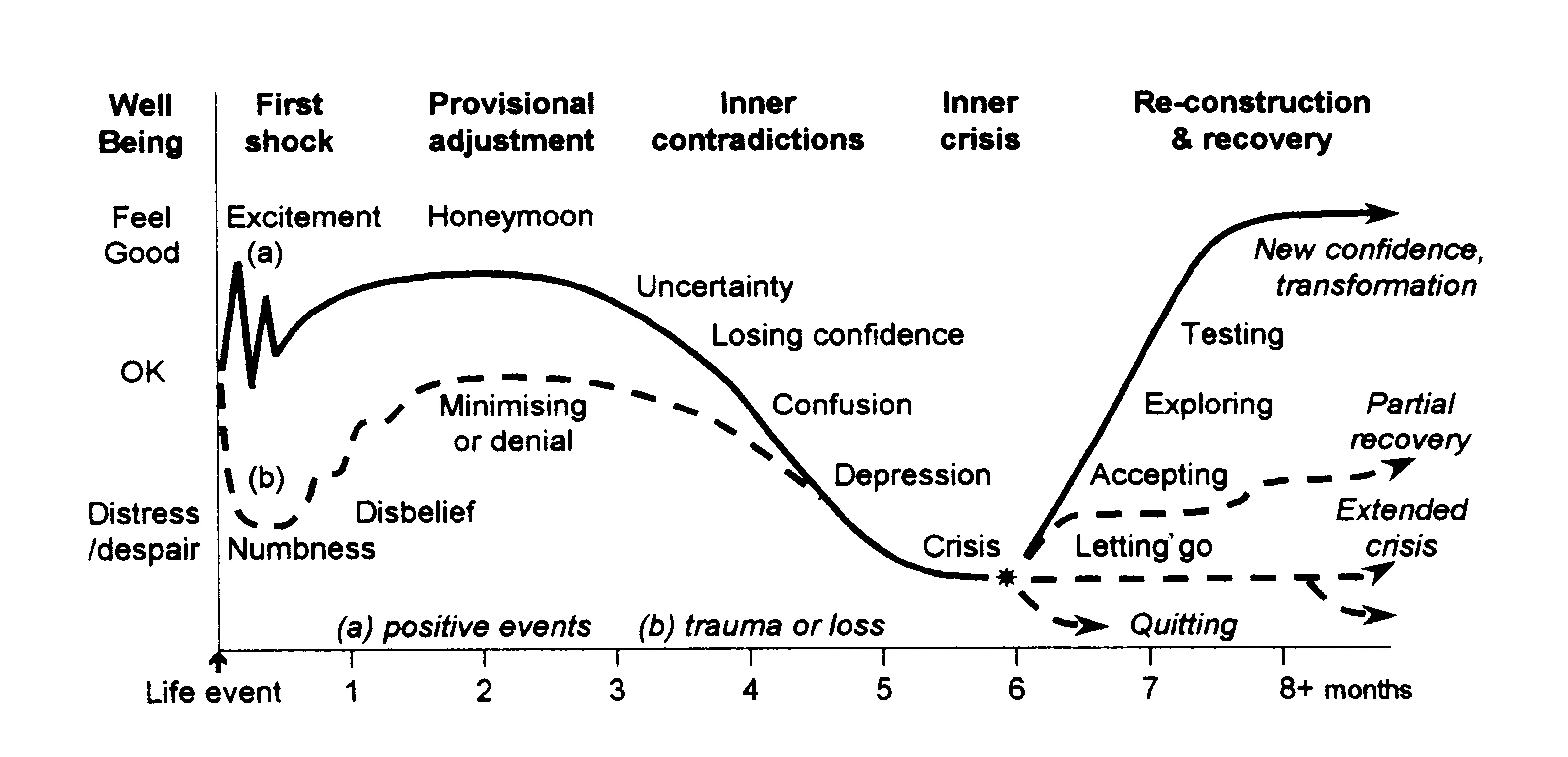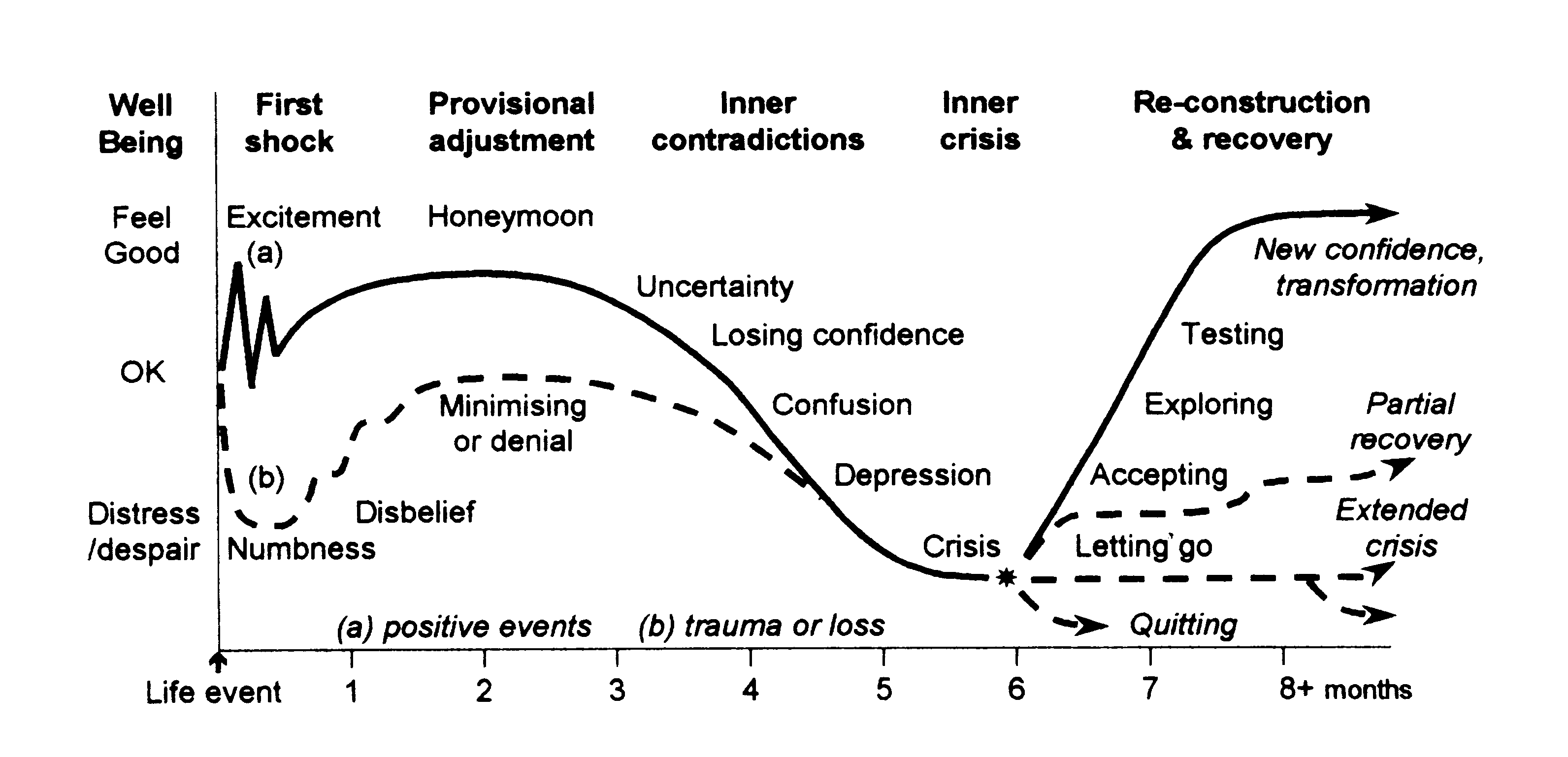
Part One of a Two-Part Series on Transitions
Almost everyone struggles with transitions – even positive changes can create stress. Transitions can really be anything, from needing to make a decision to struggling with a new job, new city, new culture, or adjusting to a new life event like marriage, the birth of a child, divorce, death in the family, etc. Psychologists have developed a theory that shows how we respond to transition follows two main paths but ultimately, each person goes through similar phases when rebounding from the feelings of uncertainty and inadequacy often created from a transition.
In today’s world, people tend to have more jobs over the span of their career, thus more times of transition. While work is only one aspect of a person’s total life experience, it is playing an increasingly primary role because we often work longer hours and technology allows for a greater connectivity to work and the associated stressors.
The model below details the common phases and features of a transition cycle, which accounts for both positive and a negative life events. Click on the image to enlarge.*
 Let’s look at this figure in relation to someone who has just made a decision to pursue a non-faculty career path. Usually, they have one of two initial responses:
1. They are excited to choose a path that fits them. Maybe they have met with a career counselor and the new option is exciting and they feel good about their career move.
or
2. Perhaps this person has realized that a faculty position will not work out, and they feel numbness and disbelief that their intended career path may not be obtainable.
Then as time goes on, both paths coalesce since making the move to a new career path can be uncertain (are you really sure you do not want that faculty job?) and confusing (there are so many career options, how do I choose?) which causes you to lack confidence that you will ever get a position. At some point you may hit a crisis—and the big question is how will you enter the reconstruction and recovery phase (and what support will you need).
With this example in mind, how then can you find a practical application for transition theory in your own life, particularly your career path?
We invite you to take a moment to consider your own transitions within your career development. Here are some questions to ask yourself as you review your career autobiography and the significant experiences, educational programs, jobs, or other events that have impacted your career choices either positively or negatively.
-- What have you considered your successes?
-- Conversely, what have you viewed as your failures?
-- How quickly did you rebound after your perceived failures?
-- What factors enabled a successful transition for you?
-- What factors inhibited a successful transition?
-- Have any of these events been defining moments for you?
-- Where would you rate yourself in this moment related to career success, satisfaction, well-being and overall stress level?
-- Do you know what kind of support is available to you?
As a follow up, and if you are inclined, sit down to meet with a career counselor to more fully explore your career timeline and what that has meant for your professional and personal development. Taking time to reflect on your past outcomes can give you insight into current issues you may be facing. It can also be helpful for understanding key transition management skills you might need to develop. For those at the NIH, the OITE can be an excellent source of support throughout your transition.
*Reference: Hopson B & Adams J (1976) Transition - Understanding and Managing Personal Change.
Let’s look at this figure in relation to someone who has just made a decision to pursue a non-faculty career path. Usually, they have one of two initial responses:
1. They are excited to choose a path that fits them. Maybe they have met with a career counselor and the new option is exciting and they feel good about their career move.
or
2. Perhaps this person has realized that a faculty position will not work out, and they feel numbness and disbelief that their intended career path may not be obtainable.
Then as time goes on, both paths coalesce since making the move to a new career path can be uncertain (are you really sure you do not want that faculty job?) and confusing (there are so many career options, how do I choose?) which causes you to lack confidence that you will ever get a position. At some point you may hit a crisis—and the big question is how will you enter the reconstruction and recovery phase (and what support will you need).
With this example in mind, how then can you find a practical application for transition theory in your own life, particularly your career path?
We invite you to take a moment to consider your own transitions within your career development. Here are some questions to ask yourself as you review your career autobiography and the significant experiences, educational programs, jobs, or other events that have impacted your career choices either positively or negatively.
-- What have you considered your successes?
-- Conversely, what have you viewed as your failures?
-- How quickly did you rebound after your perceived failures?
-- What factors enabled a successful transition for you?
-- What factors inhibited a successful transition?
-- Have any of these events been defining moments for you?
-- Where would you rate yourself in this moment related to career success, satisfaction, well-being and overall stress level?
-- Do you know what kind of support is available to you?
As a follow up, and if you are inclined, sit down to meet with a career counselor to more fully explore your career timeline and what that has meant for your professional and personal development. Taking time to reflect on your past outcomes can give you insight into current issues you may be facing. It can also be helpful for understanding key transition management skills you might need to develop. For those at the NIH, the OITE can be an excellent source of support throughout your transition.
*Reference: Hopson B & Adams J (1976) Transition - Understanding and Managing Personal Change.
 Let’s look at this figure in relation to someone who has just made a decision to pursue a non-faculty career path. Usually, they have one of two initial responses:
1. They are excited to choose a path that fits them. Maybe they have met with a career counselor and the new option is exciting and they feel good about their career move.
or
2. Perhaps this person has realized that a faculty position will not work out, and they feel numbness and disbelief that their intended career path may not be obtainable.
Then as time goes on, both paths coalesce since making the move to a new career path can be uncertain (are you really sure you do not want that faculty job?) and confusing (there are so many career options, how do I choose?) which causes you to lack confidence that you will ever get a position. At some point you may hit a crisis—and the big question is how will you enter the reconstruction and recovery phase (and what support will you need).
With this example in mind, how then can you find a practical application for transition theory in your own life, particularly your career path?
We invite you to take a moment to consider your own transitions within your career development. Here are some questions to ask yourself as you review your career autobiography and the significant experiences, educational programs, jobs, or other events that have impacted your career choices either positively or negatively.
-- What have you considered your successes?
-- Conversely, what have you viewed as your failures?
-- How quickly did you rebound after your perceived failures?
-- What factors enabled a successful transition for you?
-- What factors inhibited a successful transition?
-- Have any of these events been defining moments for you?
-- Where would you rate yourself in this moment related to career success, satisfaction, well-being and overall stress level?
-- Do you know what kind of support is available to you?
As a follow up, and if you are inclined, sit down to meet with a career counselor to more fully explore your career timeline and what that has meant for your professional and personal development. Taking time to reflect on your past outcomes can give you insight into current issues you may be facing. It can also be helpful for understanding key transition management skills you might need to develop. For those at the NIH, the OITE can be an excellent source of support throughout your transition.
*Reference: Hopson B & Adams J (1976) Transition - Understanding and Managing Personal Change.
Let’s look at this figure in relation to someone who has just made a decision to pursue a non-faculty career path. Usually, they have one of two initial responses:
1. They are excited to choose a path that fits them. Maybe they have met with a career counselor and the new option is exciting and they feel good about their career move.
or
2. Perhaps this person has realized that a faculty position will not work out, and they feel numbness and disbelief that their intended career path may not be obtainable.
Then as time goes on, both paths coalesce since making the move to a new career path can be uncertain (are you really sure you do not want that faculty job?) and confusing (there are so many career options, how do I choose?) which causes you to lack confidence that you will ever get a position. At some point you may hit a crisis—and the big question is how will you enter the reconstruction and recovery phase (and what support will you need).
With this example in mind, how then can you find a practical application for transition theory in your own life, particularly your career path?
We invite you to take a moment to consider your own transitions within your career development. Here are some questions to ask yourself as you review your career autobiography and the significant experiences, educational programs, jobs, or other events that have impacted your career choices either positively or negatively.
-- What have you considered your successes?
-- Conversely, what have you viewed as your failures?
-- How quickly did you rebound after your perceived failures?
-- What factors enabled a successful transition for you?
-- What factors inhibited a successful transition?
-- Have any of these events been defining moments for you?
-- Where would you rate yourself in this moment related to career success, satisfaction, well-being and overall stress level?
-- Do you know what kind of support is available to you?
As a follow up, and if you are inclined, sit down to meet with a career counselor to more fully explore your career timeline and what that has meant for your professional and personal development. Taking time to reflect on your past outcomes can give you insight into current issues you may be facing. It can also be helpful for understanding key transition management skills you might need to develop. For those at the NIH, the OITE can be an excellent source of support throughout your transition.
*Reference: Hopson B & Adams J (1976) Transition - Understanding and Managing Personal Change.



